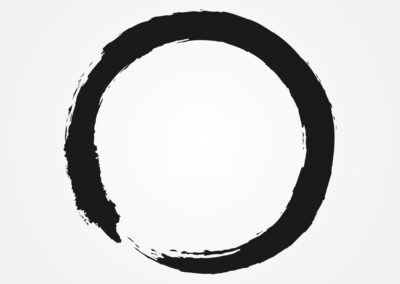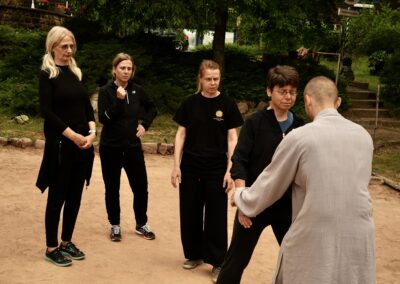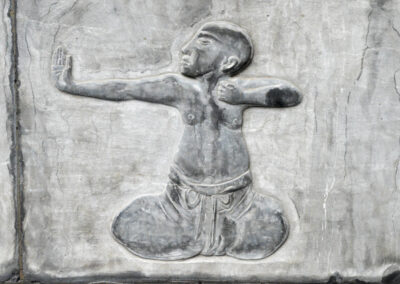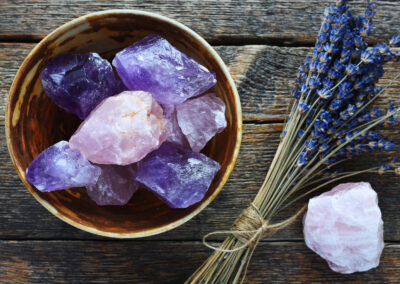„Don’t ask so much. Just do it!“
As a young person, I found things like Qi Gong and Tai Ji to be rather boring. Too little action, too little power. Nothing that I had in my mind. I wanted martial arts the way Bruce Lee and later Jackie Chan did. There had to be battle cries, hand edges, kicks and acrobatic high jumps. That was cool – I thought. Anyway! When I twisted my knee at a judo tournament and was carried off the mat, my enthusiasm for action and fighting vanished.
In this wild and disoriented time it was hardly possible for me to grasp the essence of the Qi – Gong discipline, which is inseparable from martial arts. During the meditation sessions during the long Zen sesshins in early years, I found the exercises of Qi Gong and Tai Ji to be very pleasant because they relaxed the tense body regions in the leg/hip and back areas. However, I couldn’t get more out of it.
After years of ignoring Qi Gong, I began to get a vague idea of the effect and depth of this gentle and harmonious „movement meditation“ after another „accidental encounter“. Things changed, things showed up, things cleared up, and: things got better. Not dramatically „straightforward“. No, rather gently and harmoniously through the back door.
I started to wonder how does this work? What’s behind it? The mind wanted answers. Preferably as intellectually as possible…preferably in the form of scientific papers. Checked and confirmed. So I signed up for the Qi Gong retreat at the Shaolin Monastery in Otterberg.
I’ve been there before, at the „temporary monastery“, so I should have known: people only talk very sparingly here, but practice all the more here. Shifu Shi Heng Yi led the retreat and instead of lengthy explanations, we immediately went to the practice site. More than 20 participants had gathered here in Otterberg to learn or deepen the Qi Gong sequence „Yi Jin Jing“ over the next few days.
Although the focus was on the practical exercise of the movement sequences, there were always explanations on the individual aspects of Qi Gong such as breathing, energy, movement, mindfulness, but also on topics that went much more in-depth. And they really had it all. Inspiring and eye opening!
Something I like to share.
Mindfulness: Healing and Freedom!
Qi Gong trains mindfulness/awareness. Qigong is mindfulness. The concentration on the movements, on the flow of the breath. Mindfulness means paying attention; conscious, in the present moment and non-judgmental. A Zen master was once asked why he was always so relaxed and balanced. He replied: „When I drink tea, I drink tea. When I eat, I eat and when we both talk, I listen to you.“ The questioner said: „But we do that too!“ „No,“ replied the master. „When you drink tea, your mind is elsewhere. Perhaps with your family or work. When you eat, you read the newspaper. When you talk, you are not with the other person. You are only with your own ideas.“
If we are not mindful, we live past – reality. Life is constantly overtaking us and we don’t even realize it. Reality is only in this moment.
And one more thing: body awareness (mindfulness) brings us into contact with our inner world and allows us to look into the landscape of our organism. Physically as well as mentally. We simply become aware of our blockages, our anger, our „construction sites“.
Fear, nervousness, grief, whatever is slumbering in us and always tormentingly interferes with our lives: Awareness or mindfulness immediately helps us to change our perspective and opens up new options. Unlike our automatic, habitual responses.
We perceive the impermanence of our feelings and perceptions. When we pay attention to bodily sensations, we can see the ebb and flow of our emotions. And with that, we increase our control over them.
Practical mindfulness, i.e. Qi Gong, calms the sympathetic nervous system, which ensures that you are less thrown into „fight or flight“ mode. This opens up the possibility of observing and at best tolerating the corresponding physical reactions.
However, „natural mindfulness“ only works when we no longer have to remind ourselves to be mindful. Therefore it is important that the Qi Gong exercise becomes second nature to us. That means we should practice regularly. Otherwise we are too often stuck in physical as well as mental movement.
Fascia – „autobahn“ of energy
Qi means life energy, Gong stands for work or exercise. The Qi Gong practitioner works with life energy.
This energy is everywhere. In each of us, in every animal, in every plant. Every room is filled with it. It is in the earth as well as in the water. There is not a single space in the universe without this energy. In every animate and inanimate matter. Only the frequency or the vibration is different.
Most people don’t know about this energy. Accordingly, they also do not know that this energy decreases over time, but that you can do something to replenish this energy.
If the life energy decreases, the person becomes weak, sick and dies. What makes her lose weight? Stress, lack of exercise, little sleep, bad food… and way ahead: negative thoughts. An eternally restless mind with destructive content noticeably drains one’s life energy.
If we practice Qi Gong, we use the mind, keep the body moving, and thus supply our organism with life energy. Very practical and lifelike. This also has nothing to do with esoteric mumbo-jumbo. Try it.
Interesting is the statement of Shifu, the energy moves on the fascia of the muscles. The fascia as a kind of highway of the body. The fascial system (fascial network) is the only system that is continuously connected from top to bottom. All other structures have interruptions in their path.
Frequency
At school, my interest in physics was always very limited. That has basically not changed until today.
However, I think the topic „energy – frequency“ is pretty interesting in the context of human consciousness, because it is easy to understand and conclusive. Even for me. Each of us is more or less endowed with energy. And energy always vibrates at some frequency. Every healthy cell, every organ in the human body vibrates at a certain frequency, and every deviation from the biological norm is reflected in a change in this frequency. Most of these changes don’t bode well. Wouldn’t it be a blessing if there was the possibility of keeping this frequency stable in a healthy vibration, or leading it back into a healthy vibration?
There are many ways to change the frequency and thus influence the mood and well-being of people. Both positive and negative.
Physical movement provides life energy and a „stable frequency“. A clear, mindful mind as well. Conscious breathing carries everything to its right place. All of this is included in the practice of Qi Gong.
Qi Gong and breathing!
The breath plays a major role in Qi Gong. A lot of books have been written about it. So I would like to keep this brief. The breath acts like a taxi, guiding the Qi through the body. Guided by the mind.
Experienced Qi Gong practitioners are even able to navigate this life energy to certain parts of the body with the help of their breath. In this way, blockages can be released, or impressive physical abilities can be accomplished: halve several bricks with the edges of your hands, splinter a wooden slat over your head or stomach, or lie on the tips of a sword without the aspirant being pierced. In my opinion, these exercises are somehow pointless, but they show the power of the mind. And that’s what it’s all about.
The breath is also an excellent object of meditation. When you focus on the breath, other (disturbing) factors have little chance of taking over your mind. The breath plays the most important role in Zen meditation. Sit! Sit and just breathe. Incredibly difficult!
Fine tuning of body and mind!
I think the „fine tuning“ aspect was the aspect that led me to get an inkling that Qi Gong had to be more than a simple „wellness exercise“. And I can’t really put that into words. There was a sense of a finer awareness of the body. Outside and inside. This also seemed to lead to a finer perception of the spiritual content. Logically somehow. In sport it is said: the mind goes first, the body follows. But it also works in the other direction.
You’re more intimate to what is happening in the body as well as in the mind. There is a feeling of „togetherness“. Before there was the feeling of: there is my body, there is my spirit. Now it is: I am – body and mind. I am that. There is nothing separate. Now just imagine if this feeling were not limited to your own body and mind, but also to the so-called „outside“. Unthinkable. A revolution. Some call this enlightenment.
From the 10000 things back to the one!
During the retreat, Shifu Shi Heng Yi first drew a simple circle in the sand of the „Arena“. In Zen/Chan this circle is the symbol of unity. Everything springs from this unity. I was impressed that he could get a really round circle. Just like that, with a branch lying there on the edge of the arena. Then he drew a second circle. This time the yin-yan symbol was drawn in the circle as a sign of duality (twoness). The world in which human life takes place. The world of contrasts: small and large. Good and bad, empty and full…etc. And the third circle contained the 10,000 things. In Buddhism, these „10,000 things“ symbolize the infinite variety of all phenomena. In other words, everything that creeps and flees in the universe and that we can perceive as an object.
-

Der Kreis als Symbol des "Einen"...
-

...aus dem die Zweiheit entsteht.
-

Die Elemente, aus denen alle Erscheinungen erwachsen.
When we practice Qi Gong, we initially isolate all aspects of the practice. There is the breath we focus on. Then we take care of the correct sequence of movements, the correct hand position, the rotation of the upper body. We try to keep our mind calm, because otherwise we will not be able to harmonize breath and movement.
After a period of practice, everything comes together again…into unity. Then there is no breath, no movement, no mind, no more practitioners. To be compared with listening to a piece of music that moves you, or looking at a work of art, on a walk in nature. Everything has become „One“. A revolution. Some call this enlightenment.
Spongebob !
Shi Heng Yi: It’s like a sponge: squeeze (compression) and release (expansion).
Life is tension and relaxation. Open and close. Accept and let go. Expansion and compression. Life and Death – Life is expansion, death is compression. Like everything in human existence. Inhale and exhale. Muscles have to be tensed and relaxed before they can achieve the desired range of effects.
We also find this principle in Qi Gong. We open the spine and close it. We stretch and we shrink. Both are necessary, otherwise there is stagnation or one-sidedness. A principle of life. Both must take place so that the dynamics of a healthy life can experienced. Both principles must be equally active or passive. Otherwise, we experience an imbalance, an unhealthy instability in our lives.
In today’s society, one principle seems to have gained the upper hand: Compression, or tension! Stress, burn-out, mental decompensation. And as an unwanted and uncontrollable „forced relief“: depression!
Qi Gong can bring us closer to this principle of compression and expansion in a gentle way. Our subconscious remembers and passes this message to the conscious mind.
„The Pain of Comfort- The Pain of Laziness!
At the end of the retreat in Otterberg we were still sitting comfortably with the Shifu under a large pine tree. He answered our questions and provided us with many statements about Qi Gong practice and the advice that one can talk about anything, but the point is to do it. Action is the only way to get results. And then when he talked about „the pain of laziness“, I almost felt caught. In fact, I think he looked at me with a grin on his face and meant me. It definitely was. It must have.
I do a lot of sports. However, I have to incorporate regular stretching and strength exercises into my daily routine so that my back and other parts of my body don’t ruin my day with pain. But I don’t do that regularly. I’m a lazy guy. I do it when it hurts. How stupid actually…and how fitting isn’t Shifu’s statement!?
The pain of laziness! Doesn’t sound particularly charming, but hits the nail on the head. At least for me. Basically, we only „get into the slippers“ when something hurts. Physically or mentally. Then the howling is great and we wallow in self-pity. We are all experiencing that. With ourselves or with others.
Well: for my part, I have made it my goal to practice regularly. The positive aspects of the Qi Gong exercise listed above are simply too overwhelming to continue to pay homage to and uphold the „laziness“. I was already allowed to taste the sweet nectar. it would be stupid not to pay attention to this delicacy in the future. What do you think?
Well then…cheers!
What I would like to mention here: I have never dealt intellectually with the topic of Qi Gong. I’ve never read a book about it either. Actually I have no idea at all. Perhaps the 25 years of ZEN practice are responsible for a certain openness towards the topic and the feeling that behind the curtain of the obvious, a real treasure can often be revealed. And of course the very practical experiences that happened to me while practicing. On the one hand there is meditation in silence, on the other hand meditation in motion. Zen Master Hakuin once said that the supreme meditation is meditation during everyday experience. When moving, when speaking, when working, during an argument, when breathing…every day-to-day action.
With the above text, I would like to share my experiences and thoughts related to my own Qi Gong practice…garnished with the Shifus performed during the Yi Jin Jing Retreat in June 2022. And if things go well, these words might motivate one or the other to dedicate themselves to the topic. In my opinion Qi Gong is much more than a wellness discipline. It is a complete path to holistic knowledge. Certainly, regular practice supports a healthy physical and mental life.
Amituofo!
By the way: have you ever seen the free videos from Master Shi Heng Yi about Qi Gong on his website? If not…do it:
www.shihengyi.online



















Neueste Kommentare